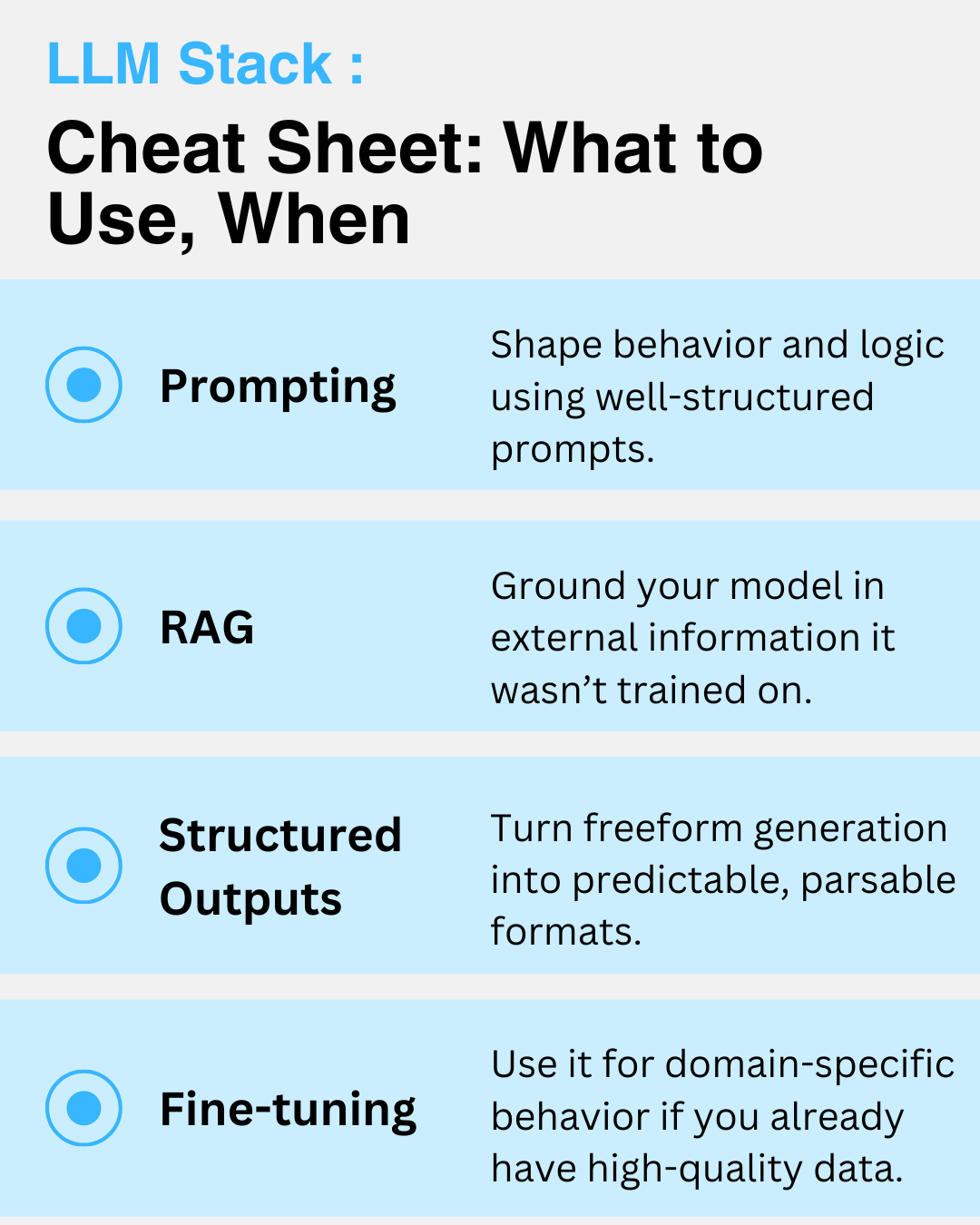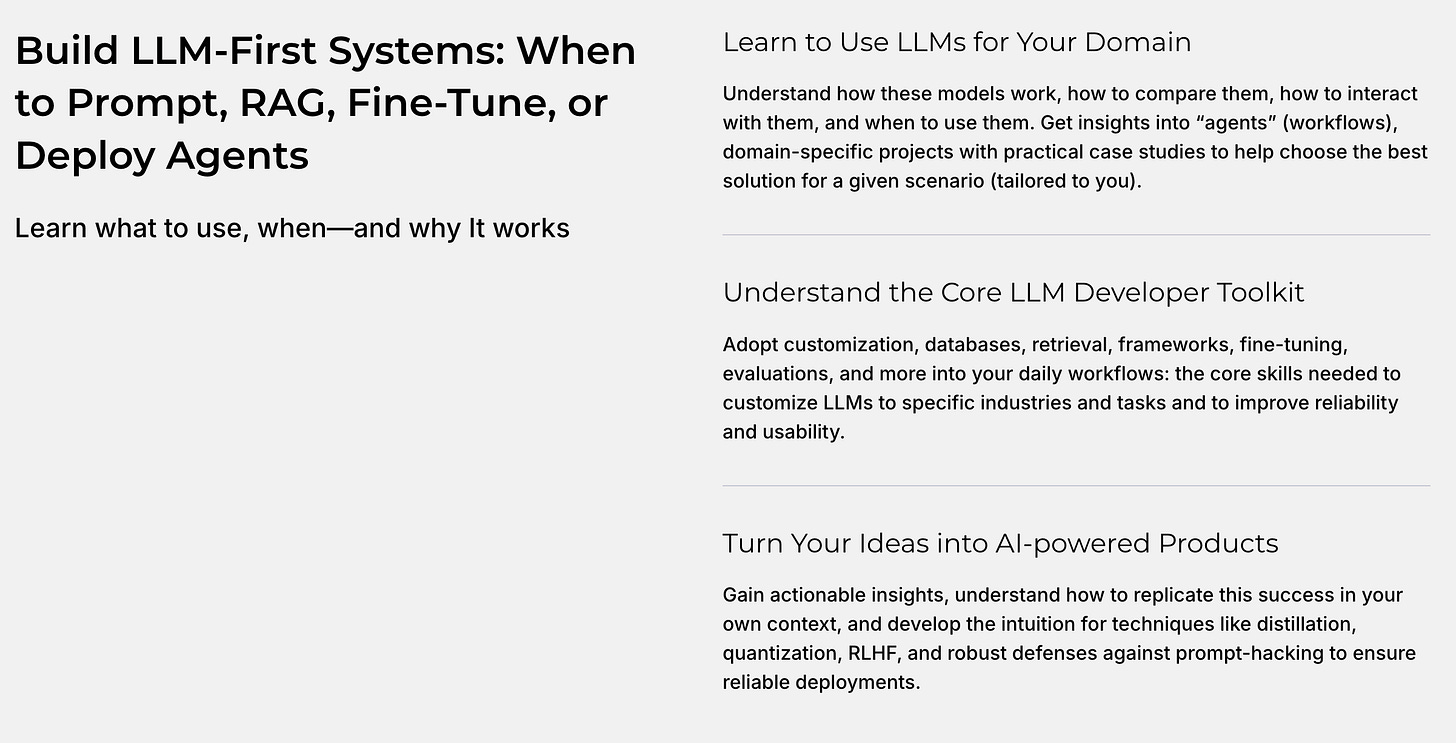Cheat Sheet: What Most Teams Miss When Building with LLMs
Lesson 2 now free: RAG, Structured Outputs, Fine-Tuning
Everyone starts with prompts.
But if you've ever built beyond a toy project, you've probably hit this wall:
The model sounds fluent but the answers are off.
The output looks good until it breaks your parser.
The demo works but doesn’t scale.
The fix? It’s not always fine-tuning. In fact, it’s almost never the first step.
That’s exactly what we walk through in Session 2 of our 10-Hour LLM Video Primer, now free to watch.
Too busy to sit through two hours? Here's the distilled cheat sheet:
LLM Stack Cheat Sheet: What to Use, When
1. Prompting: Your starting point
Shape behavior and logic using well-structured prompts.
Start with: Zero-shot, few-shot, instruction formatting
Use when: General tasks, exploration, lightweight workflows
Next step if it fails: Move to RAG, not fine-tuning
2. RAG: Inject real, dynamic knowledge
Ground your model in external information it wasn’t trained on.
Tools: LangChain, LlamaIndex, vector DBs (FAISS, Pinecone, Chroma)
Core strategies:
Smart chunking
Metadata indexing
Query rewriting
Verification loops
Multi-step reranking
Summarization + enrichment
Why it matters: Reduces hallucinations and brings domain context
3. Structured Outputs: Make answers reliable
Turn freeform generation into predictable, parsable formats.
Use when: Your system depends on clean integration or automation
Techniques:
Schema-constrained prompting
Grammar-based decoding (e.g., Context-Free Grammar)
Tools: Outlines, Pydantic (Python), Zod (JS/TS)
4. Fine-Tuning: Only when everything else falls short
Use it for narrow tasks, tone control, or domain-specific behavior, if you already have high-quality data.
Approaches: SFT, LoRA, QLoRA, RLHF, DPO, GRPO
Use cases:
Replacing domain-specific rules
Injecting unlearned behavior
Personalization at scale
Consider: Time, compute, eval pipeline; ROI must be clear
Bonus: Real-World Infrastructure
These aren't extras — they're essentials once you ship:
Evaluation: Use BLEU, ROUGE, perplexity, plus human-in-the-loop tests. Measure continuously.
Cost & Latency: Use context caching (CAG) to avoid redundant token usage; supported by OpenAI & Gemini
Tool Orchestration: Chain LLMs with APIs, agents, and conditional logic
Model Selection:
Use Gemini for long-context
o3 or GPT-4-turbo for multi-step reasoning
4.1-mini or Gemini Flash for lightweight use cases
We’ve expanded the entire production pipeline into a full 10-hour course built for developers and builders working on real-world LLM applications. In the next sessions, you’ll walk through:
Evaluating LLMs with automated metrics (BLEU, ROUGE, perplexity) and human-in-the-loop testing
Understanding agent workflows, tool use, orchestration, and how to manage cost/latency trade-offs
Applying core optimization and safety practices like quantization, distillation, RLHF, and injection mitigation
By the end, you’ll know how to build, evaluate, automate, and maintain LLM systems that hold up in production, not just on a notebook.
“Outstanding resource to master LLM development.”
“Helped me debug and design with confidence.”
“Gave me the mental model I didn’t know I was missing.”
The full course is available now at launch pricing ($199).
P.S. If you missed it, lesson 1 is also still free.





